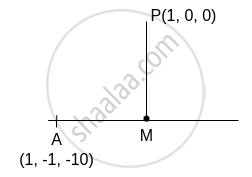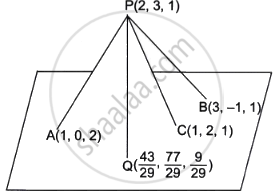Advertisements
Advertisements
प्रश्न
Find the perpendicular distance of the point (1, 0, 0) from the line `(x - 1)/(2) = (y + 1)/(-3) = (z + 10)/(8)` Also find the co-ordinates of the foot of the perpendicular.
उत्तर
Let foot of the perpendicular 'M' is drawn from point p(1, 0, 0) the line L: `(x - 1)/(2) = (y + 1)/(-3) = (z + 10)/(8)`

∴ x1 = 1, y1 = −1, z1 = −10
Direction ratios are 2, 3, -8
let L1: `(x - 1)/(2) = (y + 1)/(-3) = (z + 10)/(8)`
∴ Parametrics co-ordinates (2λ + 1, −3λ − 1, 8λ −10)
∴ The direction ratio of PM is (2λ, −3λ − 1, 8λ −10)
∴ PM is ⊥ to the given line` (2λhati(−3λ −1)hatj + (8λ −10)hatk) * (2hati - 3hatj + 8hatk) = 0`
∴ 4λ + 9λ + 3 + 64λ − 80 = 0
∴ 77λ − 77 = 0
∴ λ = 1
∴ Co-ordinates of the foot of the perpendicular are (3, −4, −2)
∴ d = `sqrt((x_2 - x_1)^2 + (y_2 - y_1)^2 + (z_2 - z_1)^2`
= `sqrt((2)^2 - (-4)^2+ (-2)^2`
= `sqrt (4 + 16 + 4)`
= `sqrt24`
∴ d = `2sqrt6`
APPEARS IN
संबंधित प्रश्न
Find the length of the perpendicular (2, –3, 1) to the line `(x + 1)/(2) = (y - 3)/(3) = (z + 1)/(-1)`.
A(1, 0, 4), B(0, -11, 13), C(2, -3, 1) are three points and D is the foot of the perpendicular from A to BC. Find the co-ordinates of D.
If the lines `(x - 1)/2 = (y + 1)/3 = (z - 1)/4 and (x - 3)/1 = (y - k)/2 = z/1` intersect each other, then find k.
Find the perpendicular distance of the origin from the plane 6x – 2y + 3z – 7 = 0.
Reduce the equation `bar"r".(3hat"i" + 4hat"j" + 12hat"k")` to normal form and hence find
(i) the length of the perpendicular from the origin to the plane
(ii) direction cosines of the normal.
Find the co-ordinates of the foot of the perpendicular drawn from the point (0, 2, 3) to the line `(x + 3)/(5) = (y - 1)/(2) = (z + 4)/(3)`.
Choose correct alternatives :
If the line `x/(3) = y/(4)` = z is perpendicular to the line `(x - 1)/k = (y + 2)/(3) = (z - 3)/(k - 1)`, then the value of k is
Choose correct alternatives :
The length of the perpendicular from (1, 6,3) to the line `x/(1) = (y - 1)/(2) =(z - 2)/(3)`
Choose correct alternatives :
The lines `x/(1) = y/(2) = z/(3) and (x - 1)/(-2) = (y - 2)/(-4) = (z - 3)/(6)` are
Choose correct alternatives :
Equation of X-axis is ______.
Choose correct alternatives :
The equation of the plane passing through (2, -1, 3) and making equal intercepts on the coordinate axes is
Solve the following :
Find the perpendicular distance of the origin from the plane 6x + 2y + 3z - 7 = 0
Solve the following :
Reduce the equation `bar"r".(6hat"i" + 8hat"j" + 24hat"k")` = 13 normal form and hence find
(i) the length of the perpendicular from the origin to the plane.
(ii) direction cosines of the normal.
The equation of X axis is ______
Find the direction ratios of the normal to the plane 2x + 3y + z = 7
Find the perpendicular distance of origin from the plane 6x − 2y + 3z - 7 = 0
The equation of a plane containing the point (1, - 1, 2) and perpendicular to the planes 2x + 3y - 2z = 5 and x + 2y - 3z = 8 is ______.
The equation of a plane containing the line of intersection of the planes 2x - y - 4 = 0 and y + 2z - 4 = 0 and passing through the point (1, 1, 0) is ______
The intercepts of the plane 3x - 4y + 6z = 48 on the co-ordinate axes are ______
If line `(2x - 4)/lambda = ("y" - 1)/2 = ("z" - 3)/1` and `(x - 1)/1 = (3"y" - 1)/lambda = ("z" - 2)/1` are perpendicular to each other then λ = ______.
Equation of the plane perpendicular to the line `x/1 = y/2 = z/3` and passing through the point (2, 3, 4) is ______
The equation of the plane through the point (2, -1, -3) and parallel to the lines `(x - 1)/3 = (y + 2)/2 = z/(-4)` and `x/2 = (y - 1)/(-3) = (z - 2)/2` is ______
The distance of the point (1, 0, 2) from the point of intersection of the line `(x - 2)/3 = (y + 1)/4 = (z - 2)/12` and the plane x - y + z = 16, is ______
Let the line `(x - 2)/3 = (y - 1)/(-5) = (z + 2)/2` lie in the plane x + 3y - αz + β = 0. Then, (α, β) equals ______
If the plane x - 3y + 5z = d passes through the point (1, 2, 4), then the lengths of intercepts cut by it on the axes of X, Y, Z are respectively ______
If plane x + ay + z = 4 has equal intercepts on axes, then 'a' is equal to ______.
Let Q be the mirror image of the point P(1, 2, 1) with respect to the plane x + 2y + 2z = 16. Let T be a plane passing through the point Q and contains the line `vecr = -hatk + λ(hati + hatj + 2hatk)`, λ ∈ R. Then, which of the following points lies on T?
The equation of the plane through the line x + y + z + 3 = 0 = 2x – y + 3z + 1 and parallel to the line `x/1 = y/2 = z/3`, is ______.
The equation of the plane passes through the point (2, 5, –3) perpendicular to the plane x + 2y + 2z = 1 and x – 2y + 3z = 4 is ______.
What will be the equation of plane passing through a point (1, 4, – 2) and parallel to the given plane – 2x + y – 3z = 9?
Find the equation of the plane containing the lines `(x - 1)/2 = (y + 1)/-1 = z/3` and `x/2 = (y - 2)/-1 = (z + 1)/3`.
Find the equation of plane which is at a distance of 4 units from the origin and which is normal to the vector `2hati - 2hatj + hatk`.
A mobile tower is situated at the top of a hill. Consider the surface on which the tower stands as a plane having points A(1, 0, 2), B(3, –1, 1) and C(1, 2, 1) on it. The mobile tower is tied with three cables from the points A, B and C such that it stands vertically on the ground. The top of the tower is at point P(2, 3, 1) as shown in the figure below. The foot of the perpendicular from the point P on the plane is at the point `Q(43/29, 77/29, 9/29)`.

Answer the following questions.
- Find the equation of the plane containing the points A, B and C.
- Find the equation of the line PQ.
- Calculate the height of the tower.
